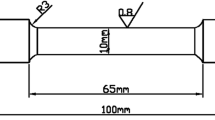Abstract
The effects of rare earth Nd on the melting behavior, wettability, microstructure and mechanical properties of Sn–0.7Cu–0.05Ni solders have been investigated in this paper. The melting temperature was found to be slightly influenced with rare earth Nd addition. Results of wetting balance tests showed that adding a proper amount of Nd could substantially improve the wettability of Sn–Cu–Ni solders by decreasing the wetting time and increasing the wetting force. The morphology evolution of solder matrix indicated that Nd contributed to the refinement and uniformity of the microstructure when added within an appropriate range. It was because the fine NdSn3 particles formed primarily in the soldering process would act as heterogeneous nucleation sites during solidification. However, excessive addition of Nd was inadvisable due to the formation of large amounts of brittle and hard NdSn3 compounds with bulk shapes. Meanwhile, moderate amount of rare earth Nd could inhibit the growth of interfacial (Cu,Ni)6Sn5 IMCs during soldering. Results of micro-joints strength test also discovered that Sn–Cu–Ni–Nd soldered joints possessed sounder shear strength, which resulted from the refined microstructure and the improved solders/Cu interfacial morphology. These above results evaluated that the optimum content of Nd added into Sn–0.7Cu–0.05Ni solders was about 0.06 wt%.












Similar content being viewed by others
References
S. Chada, Topics in lead-free solders: interfacial and Sn Whisker growth. J. Miner. Met. Mater. Soc. 64(10), 1174–1175 (2012)
L.L. Gao, S.B. Xue, L. Zhang et al., Effect of alloying elements on properties and microstructures of SnAgCu solders. Microelectron. Eng. 87(11), 2025–2034 (2010)
S.M. Hayes, N. Chawla, D.R. Frear, Interfacial fracture toughness of Pb-free solders. Microelectron. Reliab. 49(3), 269–287 (2009)
H. Ma, J.C. Suhling, A review of mechanical properties of lead-free solders for electronic packaging. J. Mater. Sci. 44(5), 1141–1158 (2009)
N. Zhao, X.Y. Liu, M.L. Huang et al., Characters of multicomponent lead-free solders. J. Mater. Sci. 24(10), 3925–3931 (2013)
G. Zeng, S.B. Xue, L. Zhang et al., Properties and microstructure of Sn–0.7Cu–0.05Ni solder bearing rare earth element Pr. J. Mater. Sci. 22(8), 1101–1108 (2011)
L. Zhang, S. Xue, L.L. Gao et al., Development of Sn–Zn lead-free solders bearing alloying elements. J. Mater. Sci. 21(1), 1–15 (2010)
S.K. Seo, S.K. Kang, D.Y. Shih et al., The evolution of microstructure and microhardness of Sn–Ag and Sn–Cu solders during high temperature aging. Microelectron. Reliab. 49(3), 288–295 (2009)
S. Liu, S.B. Xue, P. Xue et al., Present status of Sn–Zn lead-free solders bearing alloying elements. J. Mater. Sci. 26(7), 4389–4411 (2015)
H. Nishikawa, J.Y. Piao, T. Takemoto, Interfacial reaction between Sn-0.7Cu (-Ni) solder and Cu substrate. J. Electron. Mater. 35(5), 1127–1132 (2006)
T. Ventura, C.M. Gourlay, K. Nogita et al., The influence of 0–0.1 wt% Ni on the microstructure and fluidity length of Sn-0.7Cu-xNi. J. Electron. Mater. 37(1), 32–39 (2008)
T. Ventura, S. Terzi, M. Rappaz et al., Effects of Ni additions, trace elements and solidification kinetics on microstructure formation in Sn-0.7Cu solder. Acta Mater. 59(10), 4197–4206 (2011)
L. Zhang, L. Tian, Y.H. Guo et al., Wettability of SnCuNi-xEu solders and mechanical properties of solder joints. J. Rare Earths 32(12), 1184–1188 (2014)
Japanese Industrial Standards Committee, JIS Z 3198-4:2003. Test methods for lead-free solders-part 4: methods for wettability test by a wetting balance method and a contact angle method (2003)
Japanese Industrial Standards Committee, JIS Z 3198-7: 2003. Test methods for lead-free solders-part 7: methods for shear test of solder joints on chip components (2003)
J.X. Wang, S.B. Xue, Z.J. Han et al., Effects of rare earth Ce on microstructures, solderability of Sn–Ag–Cu and Sn–Cu–Ni solders as well as mechanical properties of soldered joints. J. Alloys Compd. 467(1–2), 219–226 (2009)
C. Yu, J.Y. Liu, H. Lu et al., First-principles investigation of the structural and electronic properties of Cu6−xNixSn5 (x = 0, 1, 2) intermetallic compounds. Intermetallics 15(11), 1471–1478 (2007)
L.L. Gao, S.B. Xue, L. Zhang et al., Effect of praseodymium on the microstructure and properties of Sn3.8Ag0.7Cu solder. J. Mater. Sci. 21(9), 910–916 (2010)
T. Laurila, V. Vuorinen, M. Paulasto-Kröckel, Impurity and alloying effects on interfacial reaction layers in Pb-free soldering. Mater. Sci. Eng. 68(1–2), 1–38 (2010)
Acknowledgements
This project was supported by National Natural Science Foundation of China (Grant No. 51675269) and by the State Key Laboratory of Advanced Brazing Filler Metals & Technology (Zhengzhou Research Institute of Mechanical Engineering), China (Grant No. SKLABFMT201704). This work was also supported by A Project Funded by the Priority Academic Program Development of Jiangsu Higher Education Institutions (PAPD).
Author information
Authors and Affiliations
Corresponding author
Rights and permissions
About this article
Cite this article
Liu, S., Xue, Sb., Zhong, Sj. et al. Properties and microstructure of Sn–0.7Cu–0.05Ni lead-free solders with rare earth Nd addition. J Mater Sci: Mater Electron 30, 1400–1410 (2019). https://doi.org/10.1007/s10854-018-0410-5
Received:
Accepted:
Published:
Issue Date:
DOI: https://doi.org/10.1007/s10854-018-0410-5




